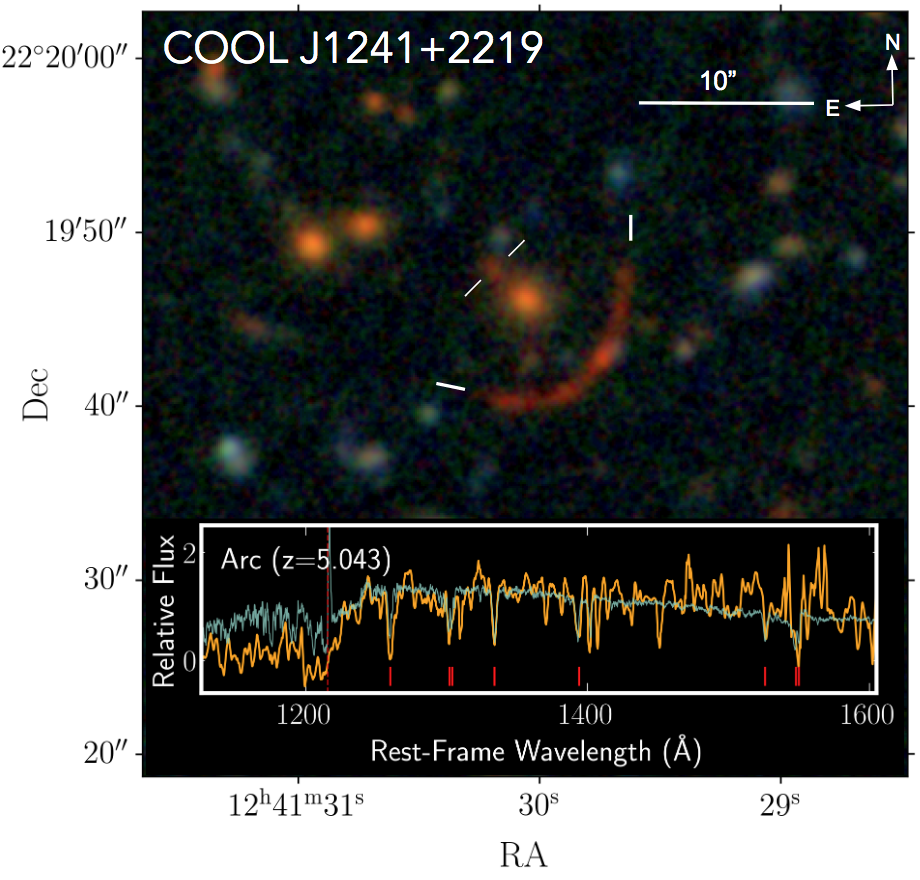The Brightest Galaxy in the Redshift > 5 Universe
COOL-LAMPS I. An Extraordinarily Bright Lensed Galaxy at
Redshift 5.04
(arXiv: 2011.06601)
Accepted in the Astrophysical Journal, December 2020

We share the discovery of COOL-J1241+2219, a lensed galaxy at z =
5.04
that is the brightest galaxy known at z > 5. This galaxy and the
cluster
lens were discovered as part of the COOL-LAMPS project — ChicagO
Optically-selected
strong Lenses - Located At the Margins of Public Surveys —
initiated to find
strongly lensed systems in recent ground-based public imaging
survey data,
consisting primarily of a team of undergraduate students.
COOL-J1241+2219 is five times brighter than the prior record-holder
at these redshifts,
at zAB = 20.5. We characterize the lensed galaxy, as well as the
brightest cluster galaxy (BCG) of
the lens cluster (at z=1.00), using ground-based grizJH band
photometry and
rest-frame UV and optical spectroscopy. We use stellar
population synthesis
(SPS) modeling to characterize galaxy properties such as the
stellar mass and
star formation rate in the lensed galaxy. Using COOL-J1241+2219
as an anchor,
we discuss the distribution of bright and lensed galaxies at z >
5.
.png)
We present COOL J1323+0343, an early-type galaxy at z=1.0153, strongly
lensed by a cluster of galaxies at z = z=0.353. This object was
originally imaged by DECaLS and noted as a gravitational lens by COOL-LAMPS,
and confirmed with follow-up data. With ground-based grzH imaging
and optical spectroscopy from the Las Campanas Observatory and the
Nordic Optical Telescope, we derive a stellar mass, metallicity, and
star-formation history from stellar-population synthesis modeling. The
lens modeling implies a total magnification of μ∼113. The median remnant
stellar mass in the source plane is 10.63 solar masses and the median star-formation
rate in the source plane is 1.55×10−3 solar masses/yr in
the youngest two age bins (0-100 Myr, closest to the epoch of observation).
Our measurements place COOL J1323+0343 below the characteristic mass of the
stellar mass function, making it an especially compelling target that could
help clarify how intermediate mass quiescent galaxies evolve. We reconstruct
COOL J1323+0343 in the source plane and fit its light profile. This object is
below the expected size-evolution of early-type galaxy at this mass with an
effective radius ~ 0.5 kpc. This extraordinarily magnified and bright lensed
early-type galaxy offers an exciting opportunity to study the morphology and
star formation history of an intermediate mass early-type galaxy in detail at z∼1 .

.png)